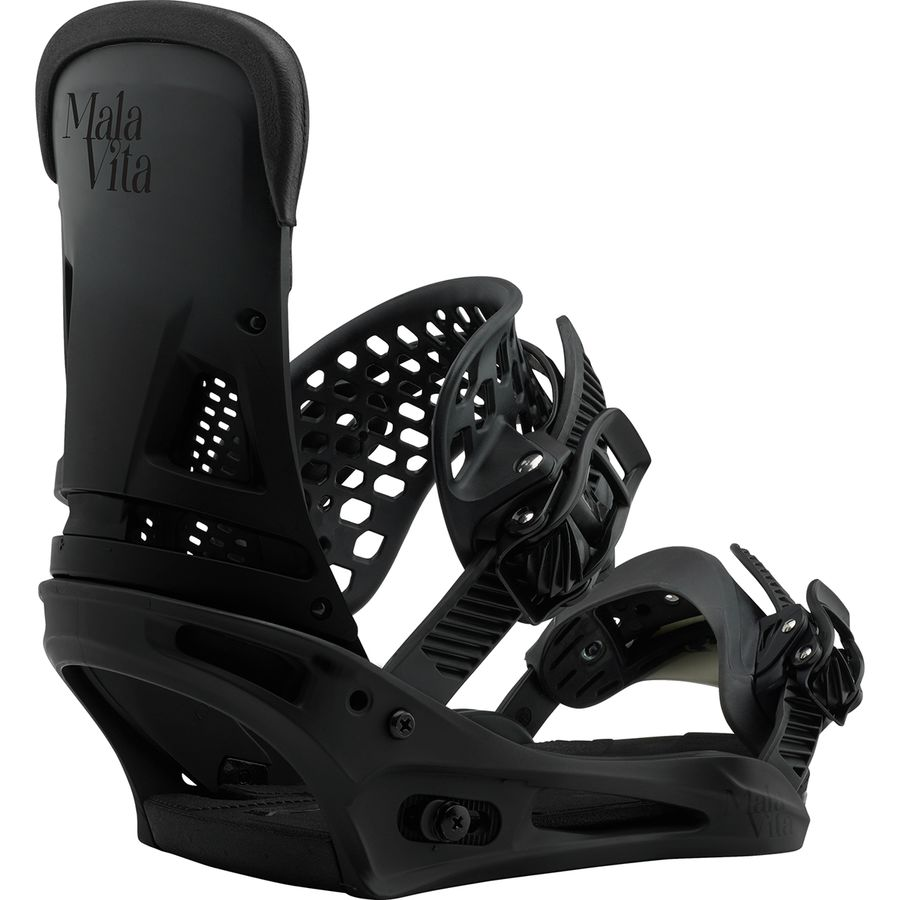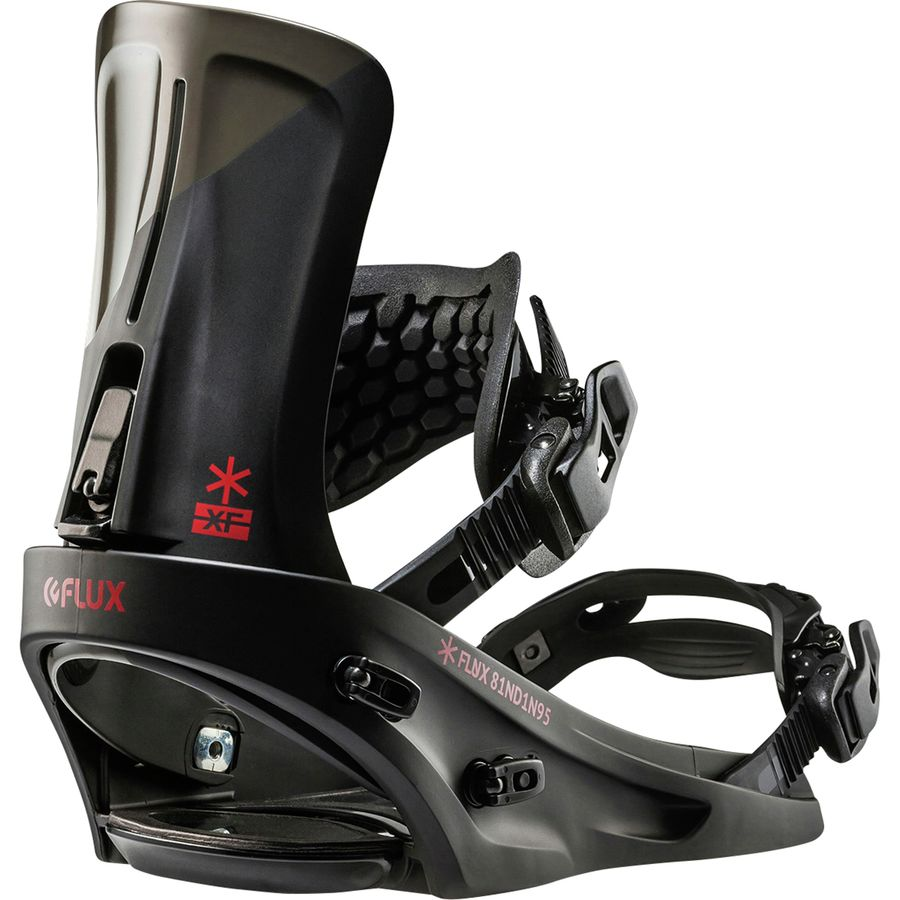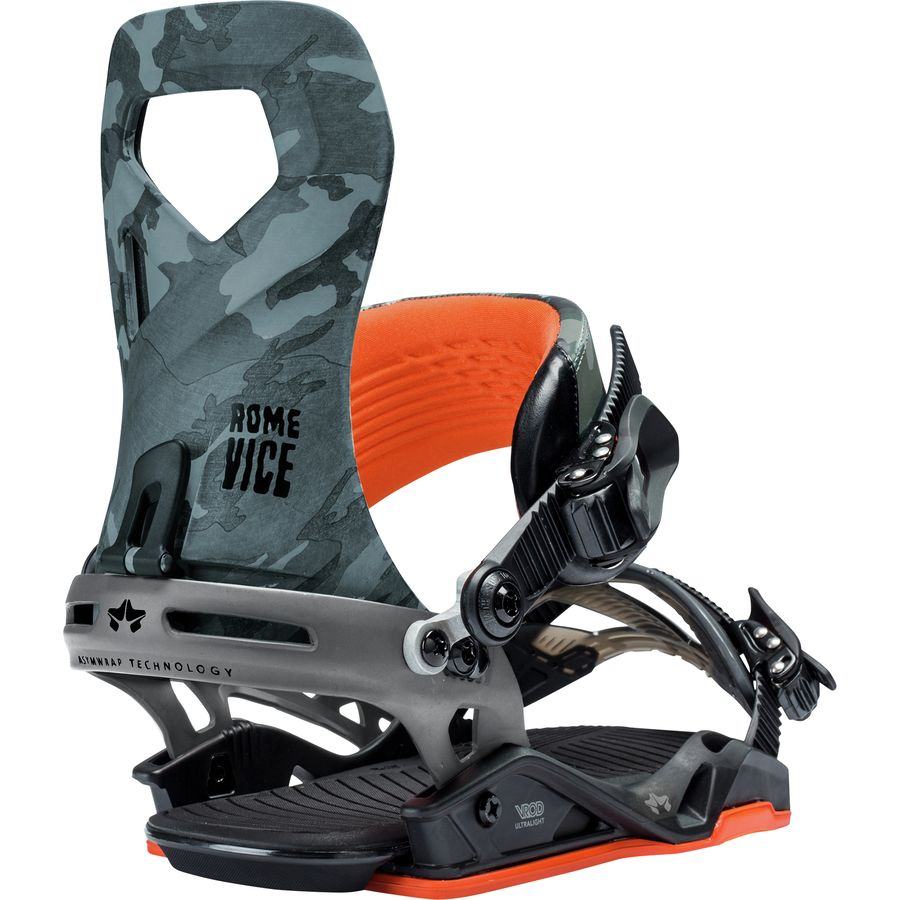



Bindings don’t get the love they deserve. They shouldn’t be some secondary gear consideration: they’re literally pivotal, a critical link between board and boots, the transfer point responsible for converting energy into action. Like the steering wheel in a race car, they dictate drive, initiate turns. And slapping a pair of sluggish, sloppy bindings on your dream snowboard will spoil an otherwise perfect setup quicker than cutting the wires on a Ferrari.

Photo Credit: Drew Zieff
If you’re looking for a pair of new bindings for the 2017-18 season, these picks from top brands like Burton, Rome, Union, Salomon, Flux and more will get the job done. In this Active Junky Snowboard Binding Buyer’s Guide, we’ve mainly focused on all-mountain bindings that put versatility first, but you’ll also find freeride bindings that are stiff as steel for straightlining steeps and flexible freestyle bindings that are built to tweak through the park.
Below, we’ll go over key considerations to keep in mind when buying a new pair of snowboard bindings: we’ll talk about various binding components, how different bindings are tuned to different riding styles, how best to fit snowboard boots to your bindings, and more. Essentially, we’ll run through everything you need to know to make a smart purchase before hitting the slopes.
Whether you’re new to snowboarding or you just need a refresher, these binding basics will get you familiar with the bare necessities.

Photo Credit: Drew Zieff
Highbacks: what enable you to make heel side turns. They’re the arched plates that run from the binding heel cup up the back of your calf. Shorter, softer highbacks are not only more comfortable, but they’re preferred by freestyle riders who crave give and flex when spinning and jibbing through the park. Freeriders, on the other hand, will lean towards taller, stiffer highbacks built more for speed, responsiveness, and stability.
The angle of your highbacks can be modified with the attached forward lean adjusters, which allow you to crank the plate forward or backward for more responsiveness or a more relaxed ride, respectively.
Baseplates: fuse your board to your bindings—they’re the foundation that you ride on, where the disc plates attach bindings to board. Cushioned footbeds overlay the baseplates. Stiffer, stronger, and streamlined baseplates are often preferred by freeriders, while freestylers tend to opt for more forgiving baseplates and cushioning.
Straps: most bindings rely on two straps—one at the toe and one at the ankle—although there are some models that use a single strap, namely FLOW’s rear-entry bindings. Back in the day, toe straps wrapped over the top of the foot, pressing the foot down. Nowadays, many bindings use a toe cap strap, which doesn’t just push the foot down, but also increases responsiveness as it pulls the boot backwards into the heel cup. Builds range from puffy and cushy park-friendly straps to sleek and streamlined freeride straps. It’s important to make sure straps both fit your boot well and deliver the level of response you require (we’ll get more into fit in the next section).

Photo Credit: Lio DelPiccolo
Ratchets: the buckles responsible for tightening bindings. You want strong, reliable ratchets that won’t wear out your straps or break in brutal conditions. A fun note, Flux’s new Beer Buckles incorporate a bottle-opener into the ratchet—just in case you need to crack a cold one on the chairlift.
Heel Cup: the rounded bar at the rear of the binding, that, as the name suggests, cups the heel. It’s common for the heel cup to be made from the same material as the baseplate, although company’s like Union have furthered snowboard binding progression by crafting extruded heel cups out of aluminum. Burton’s new Hinge technology adds two hinged joints to the heel cup for more lateral flex.
Materials: aluminum and plastic have been at the core of binding construction for years. These days, carbon is becoming more common for high-end bindings, particularly in the freeride sector, thanks to its lightweight, stiffness, and strength.
Boots, Binding, Board—1-2-3: When you’re buying a new setup, there’s a logical order of operations. If possible, buy your boots first, then your bindings, and finally your board. Just as you want to make sure your boots fit your feet, you need to make sure your bindings fit your boots, and your board fits your bindings.
Sizing Varies by Brand: Bindings typically come in three sizes: small, medium, and large, though you’ll see an XS or an XL from time to time, or even joint sizes like S/M or M/L. However, these generic binding sizes translate to different boot sizes between different brands, but manufacturers provide charts for sizing breakdowns. For example, Burton bindings fit as follows: a small fits boot sizes 6-8, a medium fits sizes 8-11, and a large is 10+. Make sure you look at the chart to ensure you’re getting the correct size.

Photo Credit: Drew Zieff
Charts Are a Start: While checking the size charts is an essential start to the process, the most important way to check for fit is to place the laced boot into the binding. The heel of the boot should fit in the heel cup without having to jam it in there. At the same time, you don’t want there to be too much wiggle room, as this will result in a washy, unsupportive ride. You’re looking for an easy in-and-out with a flush fit against the heel.
At the front of the binding, toe overhang is your enemy. Look for bindings that have a footbed that matches the length of the outsole of your boot—or at least comes marginally close. A little bit of overhang is fine, but if your toe hangs too far past the edge of the footbed, you’re losing valuable responsiveness, and may end up dealing with dreaded toe drag (another reason buying a board is the last step of the equation).
In the same vein, check that the straps fit. Straps are adjustable, true, but you don’t want to max them out by having the ratchets on the longest, furthest hole in the ladder as this might cause the toe strap to be off-center. Similarly, you also don’t want the ratchet to be on the shortest, closest hole as you might not be able to crank and tighten them enough. Go with the middle ground, if possible.
Keep Customizing: Also, once you’ve bought a pair of bindings, make an effort to customize them to your boots. Many riders think that sizing is a one-and-done game, but that’s a lazy philosophy. Tweak and perfect binding adjustments—strap length, positioning, forward lean, etc.—until they’re riding flawlessly. Engineers add those adjustments for a reason—you might as well tinker with them!
Freestyle: Freestyle bindings tend to be softer with shorter highbacks and more cushion. No surprise here, as park riders put style above all else and need to be able to tweak grabs, spin off-axis, and stomp tricks.
All-Mountain: All-mountain bindings play the middle ground between the softer, more forgiving build of a freestyle binding and the responsive, stiff chassis of a freeride binding. Top all-mountain bindings are fun in the park, confidence-inspiring on the steepest runs, and reliable everywhere in between.
Freeride: Stiff and responsive, freeride bindings often have taller highbacks. They also utilize ultralight, bombproof materials like carbon more than their freestyle compadres.

Photo Credit: Lio DelPiccolo
Each binding was evaluated against five major attributes. We then selected one key attribute in which each binding excelled, and listed it below each review.
Responsiveness
How responsive is the binding to micro-movements? Does it react quickly from toeside to heelside turns and vice versa? How does the highback react? What about the straps? Freeride and all-mountain bindings take the cake in this category.
Flex
This doesn’t necessarily mean that a binding is super soft or super stiff. Rather, it asks the question: does the binding’s flex pattern achieve its intended purpose?
Durability
Can the binding hold up to inevitable dings and drops? Does it show signs of wear and tear after weeks of testing?
Versatility
Can the binding take on everything from the steeps to the park? Groomers? Cliffs? A versatile binding needs to do it all. All-mountain bindings, we’re looking at you.
Comfort
Are the straps comfortable? Is the baseplate canted to minimize abuse to the joints? Can you ride bell-to-bell without getting tired or sore?
All-Mountain: If you’re going for an all-mountain binding, choose either the Rome Vice or the Bent Metal Transfer. We liked the Transfer a bit more for jibs, and the Vice a bit more for all-mountain domination, but both will suit all-mountain riders.
Freestyle: The Burton Malavita is our top choice in this category; tester’s loved the tweak-friendly flex.
Freeride: The Arbor Cypress has a ton of padding, while the minimalist Flux XF is less cushioned but sleeker. Both will keep freeriders stoked!
While we’re waiting for the Colorado mountains to get blanketed with snow, have a look at our 2017/18 snowboard binding previews to see what’s new and what we’re excited for this season.

A bump up from the world-famous, all-terrain Cartels, it’s no surprise that the Malavita is a top choice of pros both on and off the Burton roster. The winged highbacks (available on a couple specific colorways) reach near iconic status and facilitate swaggier jibs and more committed presses—hence making them a favorite option for freestylers. The mid-range flex is ideal for those riders who consider all-mountain riding a stew that’s bland and boring without a healthy dash of freestyle flavor. The Malavita is available in EST (for Burton’s Channel system) and Re-Flex (for universal board compatibility). One thing worth noting: only the Malavita EST version comes with The Hinge technology. The aptly-named update adds two hinges where the baseplate meets the heelcup. By increasing lateral movement, Burton claims this new-fangled flex pattern minimizes foot fatigue and facilitates easier ollies.
Key Attribute: Comfort

What goes better together than beer and waffles? Flux bindings and your favorite snowboard. Flux’s “Beer Buckles” brilliantly incorporate a bottle opener into the ratchet design, while the ankle “Waffle Strap” is a two-layer segmented strap designed with responsiveness, power, and fit in mind. A match made in heaven? Our testers aim to find out. The asymmetrical Axis highbacks are cleverly engineered: a slit down the middle supplies lateral flex, while a heavy-duty spine and a broader calf encourage heelside domination. Testers are hyped about the slim and utilitarian F.T.M. Versa toe straps (rock ‘em as traditional straps or as cap straps) and the cushioned, customizable FooTon foot beds. Given it’s adjustability, bombproof build, and array of features, the XF has the potential to be one of our favorite freeride bindings of the year.
Key Attribute: Responsiveness

An award-winning binding from the resurgent Bent Metal Binding Works, the Transfer is an impeccably-built all-mountain machine. A mid-flex pattern, comfortable and responsive highback, and durable build solidify the Transfer as a top choice. One especially remarkable feature of the Transfer is the addition of BMBW’s Flex Control Drive Plates, which emerged from Mervin’s board-building acumen (Mervin is the umbrella brand behind BMBW, Lib-Tech, Gnu, and Roxy). Ready for a tech overload? To make the Flex Control Drive Plates, Bent Metal sandwiches materials used in board construction, like eco-sublimated sheets and fiber modifiers between an EVA foam footbed up top and a reinforced nylon carriage down low to deliver customizable baseplates. The plates come in three builds: a medium-soft bi-axial version, a mid-stiff magnesium model (what the Transfer comes with) and a firm carbon edition. If you want to get a little more jibby, go with bi-axial. If speed’s your bread and you don’t care about butters, go Carbon. If you like to sample a bit of everything, get the Transfer, which comes primed with the magnesium plate.
Key Attribute: Flex

Rome’s been making some our favorite bindings for a while now. At the top of their line is the continually tweaked Katana, with which the new Vice shares many characteristics. However, the Vice is almost $100 cheaper, and is a capable, simpler, less aggressive alternative to the Katana. In fact, our testers picked the Vice over the rest of the bindings in this guide as one of our favorite bindings of 2018, as its versatility, customizability, and comfort are remarkable given the affordable pricetag.
Key Attribute: Versatility

Arbor isn’t brand new to the binding game, but they’re definitely still one of the fresh faces. However, their earth-tone aesthetic—which flows so fluidly from their board line—is already recognizable after only a couple years on the market. The Cypress, their freeride model, is designed with subtle tones and accented with burnished aluminum gracing the levers and heel cup. Whether you have one of Arbor’s decks with a classic woodgrain topsheet or a louder deck from another manufacturer, this binding makes any setup look rad. Yet, to paraphrase the wise words of Zoolander, “There’s more to bindings than being ridiculously, ridiculously good looking.”
Key Attribute: Durability